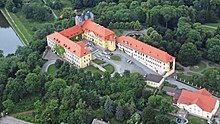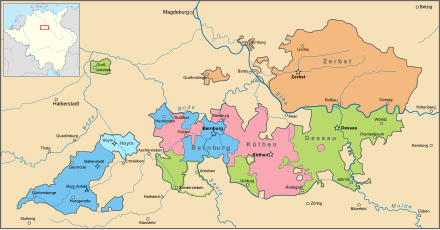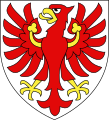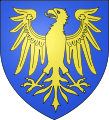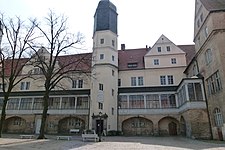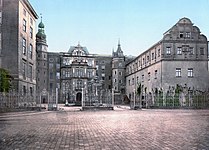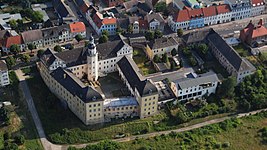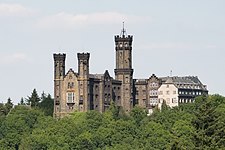Ascanians
The Askanians are a Saxon noble family that has been historically traceable since the 11th century and whose ancestral castles are Aschersleben , Ballenstedt , Bernburg and Anhalt in what is now Saxony-Anhalt . The name Askanier arose from the Latinization of their castle seat Aschersleben. The Ascanians are also known as Haus Anhalt and Anhaltiner, since only the Anhalt branch has existed since the end of the 17th century.
Albrecht the Bear became Duke of Saxony in 1138 and, with the rule of the Mark Brandenburg in 1150, the first Margrave in the former Slavic settlement area. In 1180, eastern areas of the tribal duchy of Saxony came to Bernhard of Saxony . As dukes of Saxony-Wittenberg , the Ascanians received hereditary electoral dignity in 1356 .
The sex ruled Anhalt-Dessau , Anhalt-Bernburg , Anhalt-Köthen , Anhalt-Zerbst , Anhalt-Plötzkau and Anhalt-Aschersleben . The three family castles were located in the area of Anhalt-Aschersleben, which they owned from 1252. The Anhalt Castle is located in the resin northeast of Harzgerode . Since 1863 only the Dessau line has existed, which renounced its throne in the Duchy of Anhalt due to the November Revolution in 1918 and whose head of the family is now Prince Eduard von Anhalt .
Early history
As Counts of Ballenstedt, the Askanians come from the area that today belongs to the Harz district of Saxony-Anhalt . The name Askanier was a name in use since the 14th century for the Counts of Aschersleben . It was derived from Askaria, the Latin name for Aschersleben, and was later slightly changed to Ascania, possibly based on the Greek mythical Ascanius .
Ballenstedt, Aschersleben and finally Anhalt Castle formed the three most important ancestral castles of the family in the old Schwabengau , around which the principalities of Anhalt developed over the centuries. The people of Anhalt alternately dubbed themselves “Graf von Anhalt” and “Graf von Aschersleben”. The margraves of Brandenburg until their extinction in the male line in 1320 are also referred to as Ascanians in historiography.
The oldest known Ascanians:
- Adalbert (I.) (* around 970)
- Esico († around 1060)
- Adalbert II. (* Around 1030; † 1080)
- Otto the Rich (* around 1070; † 1123), Count of Ballenstedt
- Albrecht the Bear (* around 1100, † 1170), Count von Ballenstedt, Aschersleben and Anhalt, Duke of Saxony, Margrave of the North Mark and Lusatia, Margrave of Brandenburg and his descendants
The first ancestor known by name was Esico , who exercised count rights in East Saxon districts. It was mentioned in contemporary documents, for example in a diploma issued by Emperor Conrad II on October 26, 1036 in the Palatinate Tilleda ( comitatu Esiconis means in the county of Esico). His clan was based in the East Saxon Schwabengau, which is why they are assigned to the ancient Suebian nobility settled there in the Sachsenspiegel . When schwabengau it was a east of Quedlinburg located Gaugrafschaft . The most important source for the genealogy of the early Ascanians is the Chronicle of the Annalista Saxo , who wrote it in the middle of the 12th century. Accordingly, Esico was on his mother's side a grandson of Margrave Hodo († 993) and inherited several allodial estates in Swabia and Serimuntgau after the death of his uncle Siegfried († around 1030) . The name of Esico's father is unknown; the name Adalbert (I) was only added to him in genealogies written much later , because Count Adalbert (II.), Who was murdered around 1080, is named by the Saxon annalists as the son of Esico. Esico had the collegiate monastery of St. Pancratius and Abundus built on today's Schlossberg von Ballenstedt , which was opened in 1046 in the presence of King Heinrich III. was consecrated.
Adalbert II von Ballenstedt , the son of Esico, had the two sons Otto the Rich and Siegfried .
The Saxon annalist described both Esico and the later living Adalbert (II.) And Otto the Rich as "Counts of Ballenstedt", but this title is only contemporary guaranteed for Otto (Ottoni comiti de Ballenstide) (1106), and thus is historically certain that it was named after Ballenstedt Castle in the eastern Harz. He was Duke of Saxony for a short period in 1112. The count died in 1123 and found his resting place in Ballenstedt. His wife Eilika lived in Halle and Bernburg after her husband's death. Otto the Rich and his son Albrecht the Bear converted the Ballenstedt monastery into a Benedictine monastery in 1123 .
Albrecht the Bear was the first important member of the family and the most important Ascanian in the Middle Ages, who, as a contemporary and rival of Henry the Lion ( Welfen ) and Conrad the Great ( Wettiner ), played a decisive role in the German settlement of the Slavic border brands and ultimately the Margraviate of Brandenburg in the area the then Nordmark founded. Albrecht the Bear named himself for the first time in a document issued on October 3, 1157, Margrave of Brandenburg (“Adelbertus dei gratia marchio in Brandenborch”). He served briefly as Duke of Saxony , then became Margrave of Brandenburg and established his family's position of power in the Saxon Eastern Marches. The Mark Brandenburg was in the area of the then Nordmark. On the occasion of a court day, which he presided over on August 8, 1147, Albrecht the Bear was first named as "Count of Aschersleben" (comes Asscherslovensis) . It was already used in contemporary sources "the bear". Albrecht the Bear was buried in the monastery church of Ballenstedt in 1170.
Albrecht the Bear divided his extensive territorial holdings among his sons. He had sons Otto , Hermann , Bernhard and Adalbert , among others . This formed the four main Ascanian lines at that time. These are the line from Brandenburg (until 1320), the line from Weimar-Orlamünde (until 1486), the line from Sachsen-Lauenburg (until 1689) and the line from Anhalt (until today).
Count Heinrich I von Anhalt, son of Bernhard, appeared for the first time as comes Aschariae in a document issued on November 4, 1213 . Asharia is a name that comes from the issuer of the certificate. Heinrich I was also mentioned for the first time as Count of Aschersleben and Prince of Anhalt ( comes Ascharie et princeps in Anahalt ). In the early 14th century, the family members used Anhalt, regardless of whether they owned Anhalt Castle or not. At that time the holdings were still scattered; a permanent rule did not yet exist.
Line formations of the Ascanians
The family not only ruled their homeland and other areas in what is now Saxony-Anhalt, which had "Anhalt" in their name, but also Brandenburg until 1320 , Saxony-Wittenberg until 1422 , Saxony-Lauenburg until 1689 and other areas. Saxony-Wittenberg and Saxony-Lauenburg emerged from a division of the Ascanian Duchy of Saxony , which in turn arose from the eastern part of the former tribal duchy of Saxony . The tribal duchy was mainly on the territory of today's state of Lower Saxony, but also on areas of today's Westphalia and in the western part of Saxony-Anhalt. In the 13th century the Anhaltines were among the elite in their region, that is, in the area of Anhalt. However, their importance declined sharply in the 14th and 15th centuries, which can be seen in the lower importance of imperial politics and in the marriage connections. Around 1500 the Archbishop of Magdeburg even attempted to subordinate the principality to his own sphere of influence, which would have meant the loss of the position directly under the Empire . In the middle of the 16th century progress was made in legislation, which made the administration more modern.

The first formation of lines in the area of today's Saxony-Anhalt took place through the division of the state in 1252 with the sons of Heinrich I of Anhalt . Heinrich II founded the Aschersleben line , Bernhard I the Bernburg line and Siegfried I the Koethen line . In addition to Köthen , Dessau and Coswig were in this principality. The Köthen family branch is also referred to as the older Zerbster line in older literature. Dessau was of great importance as a later residence. Ballenstedt belonged to Anhalt-Aschersleben and gave the Ascanians their name as Count of Ballenstedt. The family ruled the Principality of Anhalt-Aschersleben until 1315. The Askanians received the rule of Zerbst in 1307. The Principality of Anhalt-Zerbst was only created in 1396, as was the Principality of Anhalt-Dessau . The sons of Heinrich I founded the Aschersleben Line, the Bernburg Line and the Koethen Line in the area of today's Saxony-Anhalt. The Anhaltines also ruled the areas later (and Anhalt-Zerbst), most recently as the Duchy of Anhalt until 1918. At that time, the Ascanians did not yet rule Zerbst (1307 preserved) and the lords of Bernburg, Plötzkau (1423) and Dornburg .
In 1396, Anhalt-Köthen (also called Zerbst older line) was divided and the Albrechtsche Line and Siegmund Line arose. Albrecht III. received the land on the left bank of the Elbe (Köthen), Siegmund I. the land on the right bank of the Elbe (Zerbst). The Siegmund line acquired partial ownership of the Albrecht line. The Albrechtian line ended at the beginning of the 16th century. In 1468 the Bernburg family branch went out and the property came to the Siegmund line (the Aschersleben branch had already died out in 1315). The Siegmund line was divided again in 1474 into the older Dessau line (Anhalt-Dessau) and the older Köthener line (Anhalt-Köthen), whereby this branch of the family expired in 1562 and ownership went to the older Dessau line. The older Köthener line acquired part of the Zerbster Lande in 1508. After the family branch died out, the property fell to the older Dessau line. The older Dessau line split into the family branches Zerbst, Dessau and Plötzkau in 1546. Johann IV got the Zerbster land, Joachim Dessau and Georg III. Plötzkau. Since Wolfgang von Anhalt-Köthen († 1566) remained childless, his land fell to Joachim Ernst von Anhalt from the older Dessau line. In 1570 he was able to unite the entire possessions in one hand and moved his seat of government to Dessau.
In 1603 the inheritance was again divided into the younger lines of Anhalt-Dessau, Anhalt-Bernburg, Anhalt-Köthen and Anhalt-Zerbst. In addition, Anhalt-Plötzkau was established in 1611 and existed until the middle of the 17th century. Anhalt-Köthen-Pless (1755 to mid-19th century), Anhalt-Bernburg-Schaumburg (1707-1812) and Anhalt-Harzgerode (1635-1709) existed as other less significant lines . Anhalt-Köthen went out in 1665. Anhalt-Plötzkau received the property and was now called Anhalt-Köthen. The Zerbst family branch died out in 1793, the Köthensche line in 1847 and 1863 also the Bernburg line. Thus, in 1863, the Duchy of Anhalt (Anhalt-Dessau line) could be formed with the Dessau Residence, which was now the only dominion.
Mark Brandenburg
The Mark Brandenburg was ruled by the Ascanians until 1320 and in 1323 it was given to the Wittelsbach family as a fief.
Otto I († 1184) became the new Margrave of Brandenburg in 1170 , whose descendants ruled there until 1320 and expanded the country territorially through an expansionist Ostpolitik.
The rulers of Brandenburg
- 1134 / 1157–1170 Albrecht I the Bear (* around 1100; † 1170)
- 1170–1184 Otto I. (* around 1125; † 1184)
- 1184–1205 Otto II the Generous (* after 1147; † 1205)
- 1205–1220 Albrecht II (* before 1177; † 1220)
- 1220–1266 Johann I (* around 1213; † 1266)
- 1220-1267 Otto III. the pious (* 1215; † 1267)
- 1266–1281 Johann II. (* 1237 (?); † 1281)
- 1266–1308 Otto IV. With the arrow (* around 1238; † 1308 or 1309)
- 1266–1304 Konrad I (* around 1240; † 1304)
- 1266–1318 Heinrich I without land (* 1256; † 1318)
- 1267-1268 Johann III. the Prague
- 1267–1298 Otto V. the Long (* around 1246; † 1298)
- 1267-1300 Albrecht III. (* around 1250; † 1300)
- 1267-1303 Otto VI. the small
- 1281-1319 Conrad II.
- 1298–1308 Hermann (* around 1275; † 1308)
- 1304–1305 John IV.
- 1304–1319 Waldemar (* around 1280; † 1319)
- 1308–1317 Johann V. (* 1302; † 1317)
- 1318–1320 Heinrich II. The child (* around 1308; † 1320)
Duchy of Saxony
The old tribal duchy of Saxony was transferred to the Guelph Heinrich the Lion in 1143 . The tribal duchy of Saxony was divided into the three provinces of Westphalia , Engern and Ostfalen . It was mostly in the area of today's Lower Saxony and Westphalia as well as in the western part of Saxony-Anhalt . The dignity of the Duke of Saxony passed in 1180 after the deposition of Heinrich the Lion from the Guelphs with the Gelnhauser deed of April 13, 1180 from Emperor Friedrich I Barbarossa to the Ascanians, who only received Ostfalen. Westphalia and Engern had been separated from the Kaiser.
From the old Saxon territory, Duke Bernhard III. but only its eastern areas around Wittenberg and Lauenburg . Sachsen-Wittenberg and Sachsen-Lauenburg emerged from a division of the Ascanian Duchy of Saxony , which in turn arose from part of the former tribal duchy of Saxony . The Saxony-Wittenberg line, which was granted hereditary electoral dignity by the Golden Bull in 1356 , was important. However, it went out in 1422, and Saxony-Wittenberg ("Kursachsen") was now awarded to the Wettins , the Ascanians thus lost their membership of the electoral class .
Bernhard III. of Saxony († 1212) received the native lands of the Ascanians around Ballenstedt and Aschersleben and the ancestral castle of Anhalt . In 1180 he was given the duchy of the previously broken Duchy of Saxony , and he was thus given the title of Duke of Saxony. From the old Saxon territory he received as Bernhard III. however only its eastern areas around Wittenberg and Lauenburg .
Duke Bernhard III. again divided his territories among his sons: the older son Albrecht I († 1261) received the Saxon duchy. The younger son Heinrich I († 1252) got the Anhalt country of origin.
The regents of the tribal duchy
- 1138–1143 Albrecht the Bear (* around 1100; † 1170)
- 1180–1212 Bernhard III. (* 1140- † 1212)
- 1212–1260 Albrecht I (* around 1175; † 1260/1261)
Saxony-Wittenberg line
They were dukes and from 1355 electors of Saxony. After the death of Albrecht III. In 1422 and with it the extinction of the Wittenberg Ascanians in the male line, Saxony-Wittenberg, including his ducal and electoral dignity, was bestowed by King Sigismund on Friedrich the arguable , Margrave of Meißen, from the Wettin family, because of his involvement in imperial affairs Battle against the Bohemian Hussites.
The regents of Saxony-Wittenberg
- 1260–1298 Albrecht II (* around 1250; † 1298)
- 1298–1356 Rudolf I (* around 1284; † 1356)
- 1356–1370 Rudolf II. (* Around 1307; † 1370)
- 1370-1388 Wenceslas I (around 1337; † 1388)
- 1388–1419 Rudolf III. (* around 1373; † 1419)
- 1419–1422 Albrecht III. (* around 1375/1380; † before November 12, 1422)
Saxony-Lauenburg line

The Sachsen-Lauenburg line only died out in 1689, and the successors there were the Guelphs (from the line that ruled the neighboring principality of Lüneburg ). The only thing that remained was the Anhalt line, which in the meantime had branched into several sub-lines and was therefore historically less important.
The regents of Saxony-Lauenburg
- 1260–1282 Johann I (* 1249; † 1285), Duke
- 1282–1321 Johann II. (* Around 1275; † 1322)
- 1282-1308 Albrecht III.
- 1282–1361 Erich I (* before 1285; † 1360)
- 1321–1343 Albrecht IV (* 1315; † 1344)
- 1343-1356 Johann III. (* around 1335; † 1356)
- 1356–1370 Albrecht V (around 1335; † 1370)
- 1361–1368 Erich II. (* 1318/1320; † 1368)
- 1368-1412 Erich IV. (* 1354; † 1411)
- 1370-1401 Erich III. († 1401)
- 1412–1435 Erich V. († 1435)
- 1436–1463 Bernhard II. († 1463)
- 1463–1507 Johann IV. (* 1439; † 1507)
- 1507–1543 Magnus I (* 1470; † 1543)
- 1543–1581 Franz I (* 1510; † 1581)
- 1581–1603 Magnus II (* 1543; † 1603)
- 1603–1619 Francis II (* 1547; † 1619)
- 1619–1656 August (* 1577; † 1656)
- 1656–1665 Julius Heinrich (* 1586; † 1665)
- 1665–1666 Franz Erdmann (* 1629; † 1666)
- 1666–1689 Julius Franz (* 1641; † 1689)
Weimar-Orlamünde
Albrecht I the Bear received the county of Weimar-Orlamünde in 1140 . Orlamünde had to be sold to the Wettins on April 27, 1344 .
Hermann I († 1176) founded the line of the Counts of Weimar-Orlamünde , which, however, was less important and became extinct in the late 15th century.
The regents of Weimar-Orlamünde
- 1170–1176 Hermann I (* around 1130; † 1176)
- 1176–1206 Siegfried III. (* around 1155; † 1206)
- 1206–1245 Albrecht II (* after 1182; † before October 22, 1245)
- 1206–1247 Hermann II (* around 1184; † 1247)
- 1247–1283 Hermann III. (* around 1230; † 1283)
- 1247-1285 Otto III. the mighty (* 1244; † 1285)
- 1285–1319 Hermann IV. († 1319),
- 1285–1318 Otto IV. The Rich (* before 1279; † 1318)
- 1318-1340 Otto VI. (* 1297- † 1340)
- 1319–1365 Friedrich I († 1365)
- 1319–1335 Otto V.
- 1319–1373 Hermann VI. († 1372),
- 1340–1365 Frederick I († 1365)
Prince of Lüneburg
In 1370 the Lüneburg War of Succession broke out , as the older Lüneburg house became extinct. The principality of Lüneburg came to the Ascanians in the same year. These were in turn replaced in 1388 by Albrecht's step-sons from the Welfenhaus.
The regents of the Principality of Lüneburg
- 1370–1385: Albrecht von Sachsen-Wittenberg
(inherited from his maternal grandfather Wilhelm II (Braunschweig-Lüneburg) , ruled together with his uncle Wenzel) - 1370–1388: Wenzel I of Saxony-Wittenberg (also: Elector)
Anhalt-Aschersleben
Heinrich II was the son of Heinrich I von Anhalt . Ballenstedt and Anhalt Castle were in Anhalt-Aschersleben . The Ascanians come from this area.
The principality fell to the Halberstadt diocese in 1315 , and then to the Margraviate of Brandenburg in 1648 . The Halberstadt bishop enfeoffed Bernhard II von Anhalt-Bernburg in December 1316 , with which Anhalt-Aschersleben went to Anhalt-Bernburg as a fief.
The regents of Anhalt-Aschersleben
- 1252–1266 Heinrich II. , The fat
- 1266–1304 Otto I. († 1304)
- 1266–1283 Heinrich III. († 1307), co-regent of his brother Otto I.
- 1304–1315 Otto II († 1315/1316)
Principality of Anhalt-Bernburg
Bernhard I (* 1218; † 1287) was born as the son of Heinrich I von Anhalt and was the founder of the old Bernburg line.
Prince Bernhard III. In 1320 von Anhalt was the first to call himself comes Ascanie . The historiography of the 19th century then used the term for all members of the family of the Counts of Ballenstedt and Aschersleben since the 11th century.
After the death of Bernhard VI. In 1468 Georg I of Anhalt-Zerbst received the property.
In April 1806, Emperor Franz II made Prince Alexius Friedrich Christian Duke.
Anhalt-Bernburg came to Leopold IV. Friedrich von Anhalt-Dessau after the reign of Alexander Carl (* 1805, † 1863) .
The regents of Anhalt-Bernburg
1252-1468
- 1252–1287 Bernhard I.
- 1287–1318 Bernhard II.
- 1287–1291 Johann I (co-regent of Bernhard II.)
- 1318–1348 Bernhard III.
- 1348–1354 Bernhard IV.
- 1354–1374 Henry IV.
- 1374-1404 Otto III.
- 1404–1420 Bernhard V.
- 1404–1415 Otto IV. (Co-regent of Bernhard V.)
- 1420–1468 Bernhard VI.
- Georg I of Anhalt-Zerbst
From 1468
The land falls to Georg I von Anhalt-Zerbst in 1468 ; see section Principality of Anhalt-Zerbst. All of Anhalt was united by inheritance in 1570.
1603–1863
In 1603 it was divided into Anhalt-Bernburg, Anhalt-Dessau, Anhalt-Zerbst, Anhalt-Köthen and Anhalt-Plötzkau, which resulted in Anhalt-Bernburg being rebuilt.
- 1603–1630 Christian I of Anhalt-Bernburg , son of Joachim Ernst von Anhalt
- 1630–1656 Christian II.
- 1656-1718 Victor Amadeus
- 1718–1721 Karl Friedrich
- 1721–1765 Victor Friedrich
- 1765–1796 Friedrich Albrecht
- 1796–1834 Alexius Friedrich Christian (since 1806 Duke)
- 1834–1863 Alexander Carl
1863
The land falls to Leopold IV. Friedrich von Anhalt-Dessau; see section Principality of Anhalt-Dessau.
Anhalt-Bernburg-Schaumburg-Hoym
- 1707–1727 Lebrecht (* 1669; † 1727)
- 1727–1772 Viktor I. Amadeus Adolf (* 1693; † 1772)
- 1772–1806 Karl Ludwig (* 1723; † 1806)
- 1806–1812 Viktor II. Karl Friedrich (* 1767; † 1812)
Principality of Anhalt-Köthen
Siegfried I († 1298) was the son of Heinrich I von Anhalt and received Köthen. His son Albrecht I lived at Köthen Castle from 1295 .
Johann II ruled until 1382 and bequeathed his property to two of his sons. Albrecht III. Received the properties to the left of the Elbe bank and Siegmund I. the land to the right of the Elbe bank.
Wolfgang met Martin Luther in 1521 at the Diet in Worms . He confessed to the Reformation ; Luther also supported Elector Friedrich III in the Holy Roman Empire . of Saxony . Wolfgang also campaigned for the Reformation at the Speyer Diet in 1529 . Another reason for the early adoption of the Reformation in the principalities was the proximity to Wittenberg.
Heinrich (* 1778; † 1847) was the last Duke of Anhalt-Köthen . The land fell to the Anhalt-Bernburg lines (administered by Anhalt-Dessau) and Anhalt-Dessau. A division was waived in view of the foreseeable expiry of the Anhalt-Bernburg line and the subsequent succession to Anhalt-Dessau.
The regents of Anhalt-Köthen
1252-1570
- 1252–1298 Siegfried I (* around 1230; † after March 25, 1298), Prince
- 1298–1316 Albrecht I († 1316), son
- 1316–1362 Albrecht II († 1362), son
- 1316–1368 Waldemar I , son of Albrecht I.
- 1368–1370 Waldemar II , son
- 1370–1382 Johann II , son of Albrecht II.
- 1382-1392 Waldemar III. , Son
- 1382–1396 Siegmund I , son of Johann II.
- 1382–1423 Albrecht III. , Son of Johann II, Albrechtsche line (1396)
- 1423–1471 Waldemar IV.
- 1423–1436 Adolf I.
- 1423–1475 Albrecht IV.
- 1475–1500 Philip I
- 1475–1508 Magnus I.
- 1475–1508 Adolf II von Anhalt-Köthen , Albrechtsche line expired
1508
- 1508–1509 Georg II (* 1454; † 1509), son of Georg I of Anhalt-Zerbst
- 1508–1562 Wolfgang I (* 1492; † 1566), son of Waldemar VI. from Anhalt-Koethen
- 1562–1563 Bernhard VII. (* 1540; † 1570), son of Johann IV. Von Anhalt-Zerbst
- 1562–1586 Joachim II. Ernst (* 1536; † 1586), son of Johann IV. Von Anhalt-Zerbst
1570-1603
1570 unification of the whole of Anhalt through inheritance; see Joachim Ernst von Anhalt († 1586) in the section Principality of Anhalt-Dessau
1603-1847
1603 Division into Anhalt-Köthen, Anhalt-Dessau, Anhalt-Bernburg and Anhalt-Zerbst
- 1606–1650 Ludwig I (* 1579; † 1650)
- 1650–1653 August von Anhalt-Plötzkau was the guardian of his nephew Wilhelm Ludwig
- 1653–1659 guardian of Leberecht and Emanuel von Anhalt-Plötzkau for their cousin Wilhelm Ludwig
- 1650–1665 Wilhelm Ludwig (* 1638; † 1665), son of Ludwig I.
From 1665
The Anhalt-Köthen line became extinct, the Anhalt-Plötzkau line inherited the Köthen throne and was called Anhalt-Köthen.
- 1665–1669 Leberecht (* 1622; † 1669)
- 1665–1670 Emanuel (* 1631; † 1670), co-regent of his brother Leberecht
- 1670–1690 Anna Eleonore zu Stolberg-Wernigerode was the guardian of her son Emanuel Lebrecht
- 1671–1704 Emanuel Lebrecht (* 1671; † 1704), son of Emanuel
- 1704–1715 Gisela Agnes von Rath was the guardian of her son Leopold.
- 1704–1728 Leopold (* 1694; † 1728), son of Emanuel Lebrecht
- 1728–1755 August Ludwig (* 1697; † 1755), brother
- 1755–1789 Karl Georg Lebrecht (* 1730; † 1789)
- 1789–1812 August Christian Friedrich (* 1769; † 1812), since 1806 duke
- 1812–1817 guardian of Leopold III. Friedrich Franz von Anhalt-Dessau for Ludwig August Friedrich Emil
- 1817–1818 Leopold IV. Friedrich von Anhalt-Dessau was the guardian of Ludwig August Friedrich Emil
- 1812–1818 Ludwig August Friedrich Emil (* 1802; † 1818), son of Ludwig von Anhalt-Köthen . The Anhalt-Köthen-Plötzkau line became extinct. The branch line Anhalt-Koethen-Pleß inherited.
- 1818–1830 Friedrich Ferdinand
- 1830–1847 Heinrich (* 1778; † 1847), brother of Friedrich Ferdinand
From 1847 the
land falls under the Anhalt-Bernburg lines (administered by Anhalt-Dessau) and Anhalt-Dessau. A division is waived in view of the foreseeable expiry of the Anhalt-Bernburg line and the subsequent inheritance to Anhalt-Dessau.
Anhalt-Koethen-Pless
The regents of Anhalt-Koethen-Pless
- 1755–1797 Friedrich Erdmann (* 1731; † 1797)
- 1797–1818 Ferdinand Friedrich (* 1769; † 1830), name etc.?
- 1818–1830 Heinrich (* 1778; † 1847)
- 1830–1841 Ludwig (* 1783; † 1841), land to Heinrich, Hz. V. Anhalt-Köthen back
- 1841–1847 Heinrich (* 1778; † 1847).
(The property falls as an allodial inheritance to the nephew of Count Hans Heinrich X. von Hochberg- Fürstenstein)
Principality of Anhalt-Dessau

The area was ruled together with Koethen and Zerbst before 1396; see section Principality of Anhalt-Köthen. The Principality of Anhalt-Dessau existed from 1396 and became part of the Duchy of Anhalt as territory in 1863.
Joachim Ernst von Anhalt († 1586), son of Johann IV. Von Anhalt-Zerbst , owned all of Anhalt's holdings from 1570 and chose Dessau as his residence.
In a division between Joachim's Ernst sons in 1603, Johann Georg Anhalt-Dessau , Christian Anhalt-Bernburg , Rudolf Anhalt-Zerbst and Ludwig Anhalt-Köthen got .
Johann Georg I von Anhalt-Dessau (* 1567, † 1618), son of Joachim Ernst von Anhalt , took over sole government from 1586 to 1606 because his brothers were still minors. The division of the estate was written down in a contract in 1603 and implemented three years later. The principality was divided into Anhalt-Dessau , Anhalt-Bernburg , Anhalt-Zerbst and Anhalt-Köthen , with Johann Georg I. receiving Anhalt-Dessau and the seniorate . He died in 1618 just before the start of the Thirty Years War .
In 1660 Johann Georg II succeeded his father Johann Kasimir as regent. During his reign, Groß-Alsleben was added as a property.
Leopold I , called "Der Alte Dessauer" (* 1676; † 1747) was a Prussian army reformer and field marshal. His main achievement was the reform of the Prussian troops, especially the infantry. His regiment became the model for the entire Prussian army .
Leopold III. Friedrich Franz had the Wörlitzer Park built , a landscape garden in the English style.
The regents of Anhalt-Dessau
From 1396
- 1382–1405 Sigismund I , Siegmund Line (1396)
- 1405–1417 Waldemar V , co-regent of his brother Georg I.
- 1405–1448 Sigismund II , co-regent of his brother Georg I.
- 1405–1448 Albrecht VI. , Co-regent of his brother Georg I.
- 1405–1474 Georg I (approx. 1390; † 1474), son of Sigismund I.
From 1474
division of the area with his sons in Anhalt-Dessau and Anhalt-Köthen
- 1474–1487 Sigismund III. (* 1456; † 1487), co-regent
- 1474–1509 Georg II (* 1454; † 1509), co-regent
- 1474–1510 Rudolf IV. (* Around 1466; † 1510), co-regent
- 1474–1516 Ernst (* 1454; † 1516)
1546 (or 1544)
division of territory Division of the territory into Anhalt-Plötzkau, Anhalt-Dessau and Anhalt-Zerbst
- 1509–1561 Joachim (* 1509; † 1561), son of Ernst von Anhalt
- 1516–1551 Johann IV. (* 1504; † 1551), co-regent
- 1530–1553 George III. , the godly , co-regent
- 1561–1586 Joachim Ernst von Anhalt (* 1536; † 1586)
In 1570 all of Anhalt was united through inheritance.
- 1586–1618 Johann Georg I (* 1567; † 1618)
In 1606 (contract 1603)
the area was divided into Anhalt-Dessau, Anhalt-Bernburg, Anhalt-Köthen, Anhalt-Plötzkau and Anhalt-Zerbst.
- 1618–1660 Johann Kasimir (* 1596; † 1660)
- 1660–1693 Johann Georg II. (* 1627; † 1693)
- 1693–1698 guardian of Henriette Katharina , widow of Johann Georg II., For her son Leopold I.
- 1693–1747 Leopold I , the old Dessauer , son of Johann Georg II.
- 1747–1751 Leopold II (* 1700; † 1751)
- 1751–1758 as guardian of Dietrich for his nephew Leopold III.
- 1751–1817 Leopold III. Friedrich Franz , father Franz , son of Leopold II, from 1807 Herzograng
Duchy of Anhalt 1863
- 1817–1863 Leopold IV. Friedrich (* 1794; † 1871), from August 1863 called "Duke of Anhalt". See section Duchy of Anhalt.
Oranienbaum Palace , from 1683 summer residence of Henriette Catharina von Oranien-Nassau , wife of Prince Johann Georg II.
Castle in Wörlitzer Park , built from 1769 to 1773 by Leopold III. Friedrich Franz
Mosigkau Castle , built 1752–57 for Princess Anna Wilhelmine
Principality of Anhalt-Zerbst

Before 1396, the country was ruled together with Köthen and Dessau. The Zerbster line was discontinued in 1793 and ownership fell to the other brothers in 1797. The Köthensche line ended in 1847 and Cöthen was united with Dessau in 1853. After the Bernburg line also died out in 1863, the Duchy of Anhalt was formed under Leopold IV. Friedrich († 1871).
Anhalt-Zerbst received the rule of Jever through inheritance in 1667 .
The regents of Anhalt-Zerbst
- 1396–1405 Siegmund I , Siegmund Line (1396)
- 1405–1474 Georg I (around 1390; † 1474), son
- 1480–1508 Adolf
From 1546 (or 1544)
1544 division of the area into Anhalt-Plötzkau, Anhalt-Dessau and Anhalt-Zerbst
- 1544–1551 Johann IV. (* 1504; † 1551), son of Ernst von Anhalt († 1516) and grandson of Georg I.
- 1551–1561 Karl (* 1534; † 1561), son
- 1565–1570 Bernhard VII (* 1540; † 1570), co-regent
- 1561–1586 Joachim Ernst (* 1536; † 1586)
1570 Unification of all of Anhalt through inheritance
1603 Division
1603 Division of the area into Anhalt-Dessau, Anhalt-Bernburg, Anhalt-Köthen, Anhalt-Plötzkau and Anhalt-Zerbst
- 1603–1621 Rudolf I (* 1576; † 1621)
- 1621–1642 August von Anhalt-Plötzkau was the guardian of his nephew Johann VI.
- 1621–1667 John VI. (* 1621; † 1667), son of Rudolf I.
- 1667–1674 Sophie Auguste von Schleswig-Holstein-Gottorf was the guardian of her son Karl Wilhelm
- 1667–1718 Karl Wilhelm (* 1652; † 1718), son of Johann VI.
- 1667–1704 Johann Ludwig I (* 1656; † 1704), co-regent
- 1718–1742 Johann August (* 1677; † 1742)
- 1742–1747 Christian August (* 1690; † 1747)
- 1742–1746 Johann Ludwig II (* 1688; † 1746), co-regent
- 1747–1752 Johanna Elisabeth von Holstein-Gottorf was the guardian of her son Friedrich August, the younger brother of Catherine the Great
Anhalt-Zerbst expires in 1793
- 1747–1793 Friedrich August (* 1734; † 1793), son of Christian August. The land was divided into Anhalt-Dessau, Anhalt-Köthen and Anhalt-Bernburg.
- 1793–1796 Sophie Auguste Friederike von Anhalt-Zerbst (* 1729; † 1796), also Katharina the Great, daughter of Christian August
Coswig Castle , built 1667–1677 as a widow's residence
Dornburg Castle on the Elbe , built from 1750 as a widow's seat for Princess Mother Johanna Elisabeth , mother of Catherine the Great
Anhalt-Plötzkau
The Principality of Anhalt-Plötzkau was first established in 1544 after the division of Anhalt-Dessau and again at the beginning of the 17th century.
George III von Anhalt-Plötzkau converted to Lutheranism in 1533 and introduced it to the principality in the following Fahr. The Evangelical Church of Anhalt celebrated the 500th birthday of George III. on August 15, 2007 with an exhibition and conference.
The regents of Anhalt-Plötzkau
- 1544–1553 George III. , the godly , son of Ernst von Anhalt († 1516). The land falls back to Anhalt-Zerbst.
- 1611–1653 August (* 1575; † 1653), by hiving off Anhalt-Bernburg
- 1653–1654 guardian of Leberecht and Emanuel for her brother Ernst Gottlieb
- 1653–1654 Ernst Gottlieb (* 1620; † 1654), son of August
- 1654–1665 Leberecht (* 1622; † 1669) and Emanuel (* 1631; † 1670) jointly (takeover of Anhalt-Köthen; Anhalt-Plötzkau goes back to Anhalt-Bernburg)
Anhalt-Harzgerode
Anhalt-Harzgerode was created in 1635 from the division of Anhalt-Bernburg and returned to it in 1709.
The regents of Anhalt-Harzgerode
Duchy of Anhalt
The Zerbster line was discontinued in 1793, and the property fell to the other brothers in 1797. The Köthensche line ended in 1847, and Cöthen was united with Dessau in 1853. When the Bernburg line also died out in 1863, the Duchy of Anhalt was created under Duke Leopold IV. Friedrich († 1871).
The duchy formed a closed national territory, apart from the Ballenstedt district and the exclaves Großalsleben , Tilkerode , Mühlingen , Dornburg and Gödnitz . The Prussian enclaves Priorau-Schierau-Möst, Löbnitz, Repau and Pösigk were within the duchy. The capital of Anhalt was Dessau in the east of the duchy. In addition to Dessau, there were also residences in Oranienbaum, Mosigkau, Ballenstedt, Bernburg, Köthen and Zerbst. The population was about 331,000 in 1910. The Protestant faith was almost completely widespread, only 4 percent were Catholics and 0.5 percent Jews.
In the federal decision of June 14, 1866, the Duchy of Anhalt agreed with Prussia , joined the North German Confederation in 1867 and the German Empire in 1871 . The state parliament was composed of 36 members. The Duke appointed 2 MPs, 8 MPs represented the most taxed landowners, 2 the most taxed traders, 14 MPs represented the cities and 10 MPs the rural areas.
The duchy existed until the November Revolution in 1918 and then became the Free State of Anhalt . This year workers and soldiers demonstrated in Anhalt, and this happened peacefully. The Social Democrats advocated the abdication of the ducal family. On November 12, 1918, Prince Regent Aribert von Anhalt , on behalf of the minor Duke Joachim Ernst, renounced the throne for the Ascanians.
The regents of Anhalt
- 1863–1871 Leopold IV. Friedrich (* 1794, † 1871)
- 1871–1904 Friedrich I (* 1831, † 1904)
- 1904–1918 Friedrich II. (* 1856, † 1918)
- 1918 Eduard (* 1861, † 1918)
- 1918 Joachim Ernst (* 1901, † 1947) under the tutelage of the regent Aribert
Katharina the great
The best-known and historically most important representative of the Ascanians in modern times was Sophie Auguste Friederike von Anhalt-Zerbst-Dornburg (* 1729; † 1796), whose father was in Prussian service, which is why she did not grow up in Zerbst, but in Szczecin Castle . In 1745 she was married to Karl Peter Ulrich von Schleswig-Holstein-Gottorf, the future Russian Tsar Peter III. , and on this occasion adopted the Russian Orthodox faith with the name Ekaterina Alexejewna. After she had disempowered her husband in 1762, who was murdered in the process, she assumed sole rule as Tsarina Catherine II in Russia , which she ruled for 34 years.
The house of Anhalt since the end of the monarchy
In 1918, Aribert von Anhalt declared that his underage nephew Joachim Ernst renounced the throne as duke. After the November Revolution and the end of the monarchy , the Free State of Anhalt emerged , which was called Land Anhalt from 1934 and existed until 1945.
Joachim Ernst was the head of the family until 1947. His eldest son Friedrich held this position until 1963, then his brother Eduard Prinz von Anhalt (* 1941). The current boss and his three daughters are the only legitimate descendants of the Ascanians in the Agnatic tribe. The family carries the traditional nobility predicate " Highness ", which is used both for the boss and for the other family members. With the Counts of Westarp and von Waldersee there are still two morganatic lineages of the sex that arose from illegitimate connections between two princes of Anhalt.
In addition, there are still a large number of name-bearers who have been adopted as adults. The number of adoptees and their family members with the same surname clearly outnumbered the native Ascanians. These "Princes of Anhalt" are not considered part of the family by Eduard von Anhalt. Frédéric Prinz von Anhalt , who was adopted by Marie Auguste von Anhalt in 1980 and who has also adopted numerous adults himself, is best known among those adopted .
Eduard von Anhalt is the last male Ascanian; the family will be extinct in the male line after his death . In January 2010, as head of the house, he changed the house law and introduced female succession with equal rights. His eldest daughter, Julia Katharina, is the heir to the Anhalt family. Eduard von Anhalt is the first head of a formerly ruling German noble house that also made female succession possible.
Heads of the House of Anhalt
- 1918–1947 Joachim Ernst (* 1901; † 1947), son of Duke Eduard von Anhalt
- 1947–1963 Leopold Friedrich Franz (* 1938; † 1963), son
- since 1963 Julius Eduard (* 1941), brother
Research activities
Since the 16th century, house historians of the Anhaltin and Sachsen-Lauenburg family branches tried to derive the descent of their employers from Ascanius , the son of the Trojan hero Aeneas , or even from the biblical Ashkenaz , the great-grandson of Noach . It started in 1519 with the “Panegiricus Genealogiarum illustrium Principum Dominorum in Anhalt” by the Ballenstadt monk Heinrich Basse. In 1556 Ernst Brotuff published the "Genealogia and Chronica of the Serene and Highly Born Royal and Princely House of the Princes of Anhalt", with which an extensive line of ancestors was continuously represented. Esico von Ballenstedt did not come from the Beringer family, as was falsely claimed .
In 1912 and 1913, the ducal archivist Hermann Waschke published the three-volume "Anhalt History", which is a representation of the overall history of Anhalt and became a standard work .
coat of arms
Buildings of the Ascanians
Ballenstedt Castle
Coswig Castle
Senior citizens of the House of Anhalt
According to the partition agreement of 1603, the seniors managed the entire affairs of the house in Anhalt.
- 1603–1618 Johann Georg I of Dessau , (* 1567; † 1618), Prince
- 1618–1630 Christian I of Bernburg (* 1568; † 1630)
- 1630–1653 August von Plötzkau (* 1575; † 1653)
- 1653–1660 Johann Kasimir von Dessau (* 1596; † 1660)
- 1660–1670 Friedrich von Harzgerode (* 1613; † 1670)
- 1670–1693 Johann Georg II of Dessau (* 1627; † 1693)
- 1693–1718 Victor I. Amadeus von Bernburg (* 1634; † 1718)
- 1718 Karl Wilhelm von Zerbst (* 1652; † 1718)
- 1718–1721 Karl Friedrich von Bernburg (* 1668; † 1721)
- 1721–1747 Leopold von Dessau , called "The Old Dessauer"
- 1747–1755 August Ludwig von Köthen (* 1697; † 1755)
- 1755–1765 Viktor II. Friedrich von Bernburg (* 1700; † 1765)
- 1765–1789 Karl Georg Lebrecht von Köthen (* 1730; † 1789)
- 1789–1796 Friedrich Albrecht von Bernburg (* 1735; † 1796)
- 1796–1817 Leopold III. Friedrich Franz von Dessau (* 1740; † 1817)
- 1817–1834 Alexius Friedrich Christian von Bernburg (* 1767; † 1834), from now on duke
- 1834–1847 Heinrich von Köthen (* 1778; † 1847)
- 1847–1863 Leopold Friedrich von Dessau (* 1794; † 1871)
Ascan abbesses
Gernrode Abbey
- 1044-1046 Hazecha von Ballenstedt
- 1221–1244 Sophia von Anhalt († 1244)
- 1267–1296 Mathilde I of Braunschweig
- 1348–1374 Adelheid III. from Anhalt
- 1445–1463 Mechthild II of Anhalt (* 1392; † 1463)
- 1469–1504 Scholastica von Anhalt (* 1451; † 1504)
- 1565–1569 Elizabeth III. from Anhalt
- 1570–1577 Anna Maria von Anhalt (* 1561; † 1605)
- 1578–1581 Agnes Hedwig von Anhalt (* 1573; † 1616)
- 1586–1593 Dorothea Maria von Anhalt (* 1574; † 1617)
- 1593–1610 Sophia Elisabeth von Anhalt
Gandersheim Monastery
- 1485-1504 Agnes III. von Anhalt (* 1445; † 1504)
Overview of the country divisions
Name bearer through adult adoption
- Frédéric von Anhalt (* 1943)
- Marcus von Anhalt (* 1966)
See also
literature
- Lorenz Friedrich Beck: rule and territory of the dukes of Saxony-Wittenberg (1212-1422). (= Library of Brandenburg and Prussian History, Volume 6), Potsdam 2000.
- Werner Freitag, Michael Hecht (ed.): The princes of Anhalt. Symbolism of rule, dynastic reason and political concepts in the late Middle Ages and early modern times. Halle (Saale) 2009, ISBN 978-3-89812-199-6 .
- Michael Hecht: The Invention of the Ascanians. Dynastic Memorial Foundation of the Princes of Anhalt at the turn of the Middle Ages to the modern age, In: Journal for historical research Volume 33 (2006), pp. 1–32
- Gerd Heinrich: Ascanians . In: Lexicon of the Middle Ages (LexMA). Volume 1, Artemis & Winkler, Munich / Zurich 1980, ISBN 3-7608-8901-8 , Sp. 1109–1112.
- Jörg Meyn: From the late medieval regional duchy to the early modern “territorial state”. The Ascanian Duchy of Saxony 1180–1543. (= Series of publications by the Duchy of Lauenburg Foundation, Volume 20), Hamburg 1995.
- Britta Kägler , Michael Hecht: Dynasties and high nobility: The Anhalt Ascanians / The Bavarian Wittelsbachers , in: Werner Freitag, Michael Kißener, Christine Reinle, Sabine Ullmann, Sabine (eds.): Handbuch Landesgeschichte , Berlin 2018, pp. 268-302.
- Lutz Partenheimer : Albrecht the Bear. Founder of the Mark Brandenburg and the Principality of Anhalt. 2nd edition, Böhlau, Cologne / Weimar / Vienna 2003, ISBN 3-412-16302-3 ,
- Lutz Partenheimer: The early Ascanians and the emergence of Anhalt. In: 800 years of Anhalt. History, culture, perspectives (Stekos historical library 2). Published by the Anhaltisches Heimatbund, Dößel 2012, pp. 153–173.
- Ralf Regener: The fall of the Ascanians in Anhalt in 1918. Conditions, course and aftermath of the fall of a small German monarchy . Dessau-Roßlau 2013.
- Mathias Tullner : History of Saxony-Anhalt . Beck, Munich 2008, ISBN 978-3-406-57286-9 .
Web links
- Askanier Academy of Sciences, Göttingen
Individual evidence
- ↑ Gerd Heinrich: Askanier . In: Lexicon of the Middle Ages (LexMA). Volume 1, Artemis & Winkler, Munich / Zurich 1980, ISBN 3-7608-8901-8 , Sp. 1109–1112.
- ↑ Michael Hecht: The Anhalt Ascanians. In: Werner Freitag (Ed.): Handbook of regional history. Berlin 2018, p. 271.
- ↑ Monumenta Germaniae Historica (MGH) DD K II, No. 234, p. 319.
- ↑ Annalista Saxo , ed. by Georg Heinrich Pertz in: MGH SS 6 (1844), p. 678
- ↑ Annalista Saxo , ed. by Georg Heinrich Pertz in: MGH SS 6 (1844), p. 676
- ↑ Annalista Saxo , ed. by Georg Heinrich Pertz in: MGH SS 6 (1844), p. 744
- ↑ Codex diplomaticus Anhaltinus (CDA) , Part I, No. 436
- ↑ CDA , Part I, No. 337.
- ↑ Michael Hecht: The Anhalt Ascanians. In: Werner Freitag (Ed.): Handbook of regional history. Berlin 2018, p. 271.
- ↑ CDA , Vol. 2, No. 9, pp. 8-9
- ↑ Michael Hecht: The Anhalt Ascanians. In: Werner Freitag (Ed.): Handbook of regional history. Berlin 2018, p. 272.
- ↑ Michael Hecht: The Anhalt Ascanians. In: Werner Freitag (Ed.): Handbook of regional history. Berlin 2018, p. 273.
- ^ Köbler, Gerhard: Historisches Lexikon der deutschen Länder , Munich, 2019, p. 17.
- ^ Köbler, Gerhard: Historisches Lexikon der deutschen Länder , Munich, 2019, p. 17.
- ^ Köbler, Gerhard: Historisches Lexikon der deutschen Länder , Munich, 2019, p. 17.
- ^ Köbler, Gerhard: Historisches Lexikon der deutschen Länder , Munich, 2019, p. 17.
- ^ Köbler, Gerhard: Historisches Lexikon der deutschen Länder , Munich, 2019, p. 17.
- ^ Köbler, Gerhard: Historisches Lexikon der deutschen Länder , Munich, 2019, p. 17.
- ↑ Askanier www.manfredhiebl.de
- ↑ CDA , Part III, No. 406
- ^ Matthias Prasse: Brief illustrated history of the state of Anhalt . Herrenhaus-Kultur-Verlag, Dresden 2014, p. 74 .
- ^ Draft of a documented, pragmatic history of the Duke and Kuhr Duchy of New Saxony as the so-called Kuhr or Wittenberg district; with the Duchies of Anhalt ... from the pastor, Karl Limmer, 1838. books.google.de
- ↑ Duchy of Anhalt deutsche-schutzgebiete.de
- ^ Matthias Prasse: Brief illustrated history of the state of Anhalt . Herrenhaus-Kultur-Verlag, Dresden 2014, p. 87 f .
- ^ Julius Eduard Prince of Anhalt: Update of the house law of the Anhalt-Askanien family. Berlin, January 1, 2010. [1]


